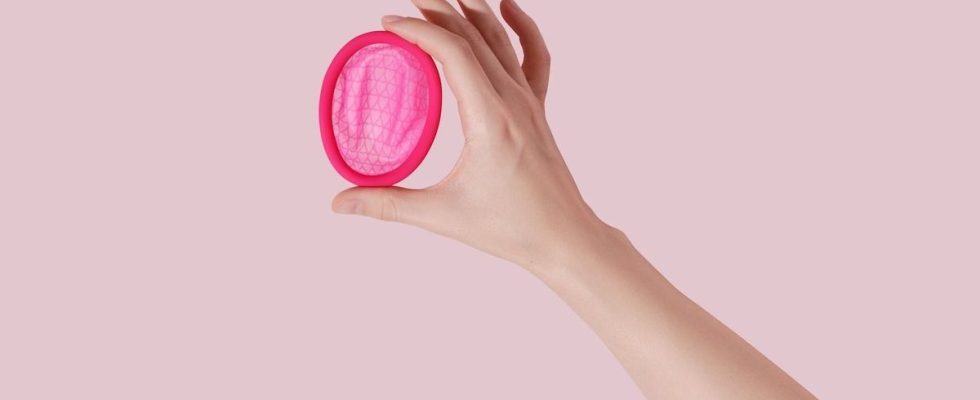Published on
Updated
Reading 4 mins.
in collaboration with
Dr Odile Bagot (Gynecologist-obstetrician)
For many women, heavy periods can become a real daily constraint. Subject still taboo, researchers have decided to compare the absorption efficiency of sanitary protection on the market. A new hygienic protection, the menstrual disc, would be the most effective for heavy menstrual flows. Answers with our gyneco-obstetrics specialist, Dr. Odile Bagot.
Menstruation is a natural occurrence, marking a new milestone in a girl’s life. Worldwide, 1 in 3 women suffer from heavy menstrual flow. On a daily basis, it can be very demanding physically, psychologically, but also financially. “Although common, it can be a sign of underlying health conditions, such as a bleeding disorder or fibroids”add the researchers of the study published online in the journal BMJ Sexual & Reproductive Health. According to these scientists, menstrual discs – little known in France and mainly sold on the internet – could be a solution for women with heavy periods.
Menstrual discs: what are they?
After washable sanitary napkins, panties and menstrual cups, menstrual discs have recently emerged. A new alternative to disposable tampons and sanitary napkins, menstrual discs are reusable medical silicone pads. Measuring between 6 to 7 cm in diameter, it must be placed in the fornix of the vagina, unlike menstrual cups which are placed in the vaginal canal.
To insert and place it correctly, simply bend the disc edge to edge to make it thinner and then push it to the top of the vagina. The latter will be retained by the pubis to stay in place for almost 10 hours. Thereafter, it is removed quite easily.
Attention, even if it is possible to have sexual intercourse while wearing these menstrual discs, it remains only hygienic protections, and not a means of contraception.
Twenty periodical products tested with blood
As the researchers point out, the Pictorial Blood Loss Assessment Chart (PBAC) helps quantify menstrual blood loss. The latter is based on the type, number and saturation of sanitary napkins as well as menstrual tampons, to capture abnormally abundant blood flow. However, alternative sanitary protection such as discs, cups and absorbent panties have not yet been included in this table, despite their high popularity.
According to scientists, even today, “There is no industry standard for capacitance testing, except for tampons due to their historical link to the risk of toxic shock syndrome. And the reported capacity is based on saline solution or water, which is nothing like menstrual blood,” add the researchers in their Press release. The researchers therefore decided to compare the absorption capacity of 21 menstrual hygiene products, commercially available and commonly used by women.
A better flow of absorption than other hygienic protections?
For their study, the researchers had to assess the absorption rate of these many products using blood. “Most of the studies on sanitary protections are made with water or a saline solution. Here we use blood, but which is still different from the real blood of the periods.”, explains Dr. Bagot. As a result, menstrual discs would be more suitable than other hygienic protections in the event of heavy flow. Indeed, these products have collected the most blood than the others, with an average of up to 61 ml (and even 80ml for those of the Jiggy brand). This amount of blood is diagnostic of excessive blood loss. In contrast, tampons, pads and menstrual cups contained similar amounts, between 20 to 50 ml.
The researchers also found that there was a discrepancy between reported and actual absorbency. “We also found that product capacity labeling was inconsistent with our results – the majority of products indicated that they had a higher capacity than our tests found. We suspect this is due to tests of products with non-blood fluids, such as water or saline solution”explain the researchers before adding, that a “Better understanding of the ability of new menstrual products may help clinicians better quantify menstrual blood loss, offer diagnostic tests, and accurately treat heavy menstrual bleeding.” For Dr. Odile Bagot, “the announcements of the capacity of the protections are always overestimated”.
The scientists also say their discovery has limitations: “the results of laboratory tests are not the same as those obtained on humans. Comfort and convenience may also prompt women to switch products before saturation, which may overestimate abundant blood flow.”
For Dr. Odile Bagot, “it’s a good thing to have hygienic protections with a great capacity to absorb the menstrual flow”. However, she reminds us that it is above all “it is essential to consult a gynecologist to find the cause of these heavy periods and find a solution so that the patient bleeds less.” An abundant menstrual flow can be caused by the presence of a cyst, a polyp, an adenomyosis or even a hormonal imbalance.
